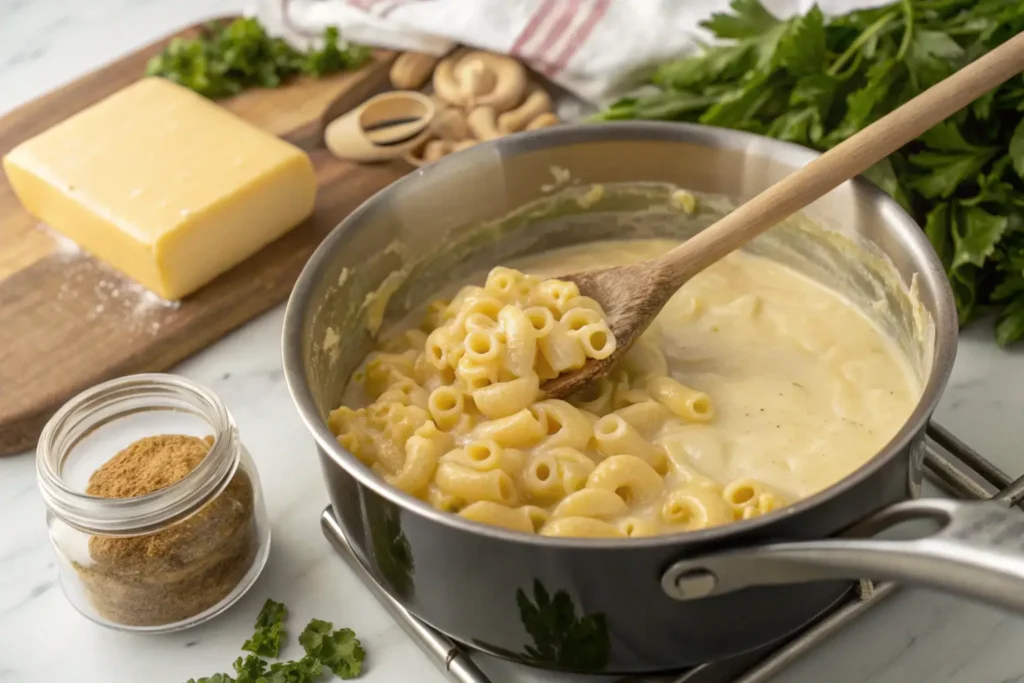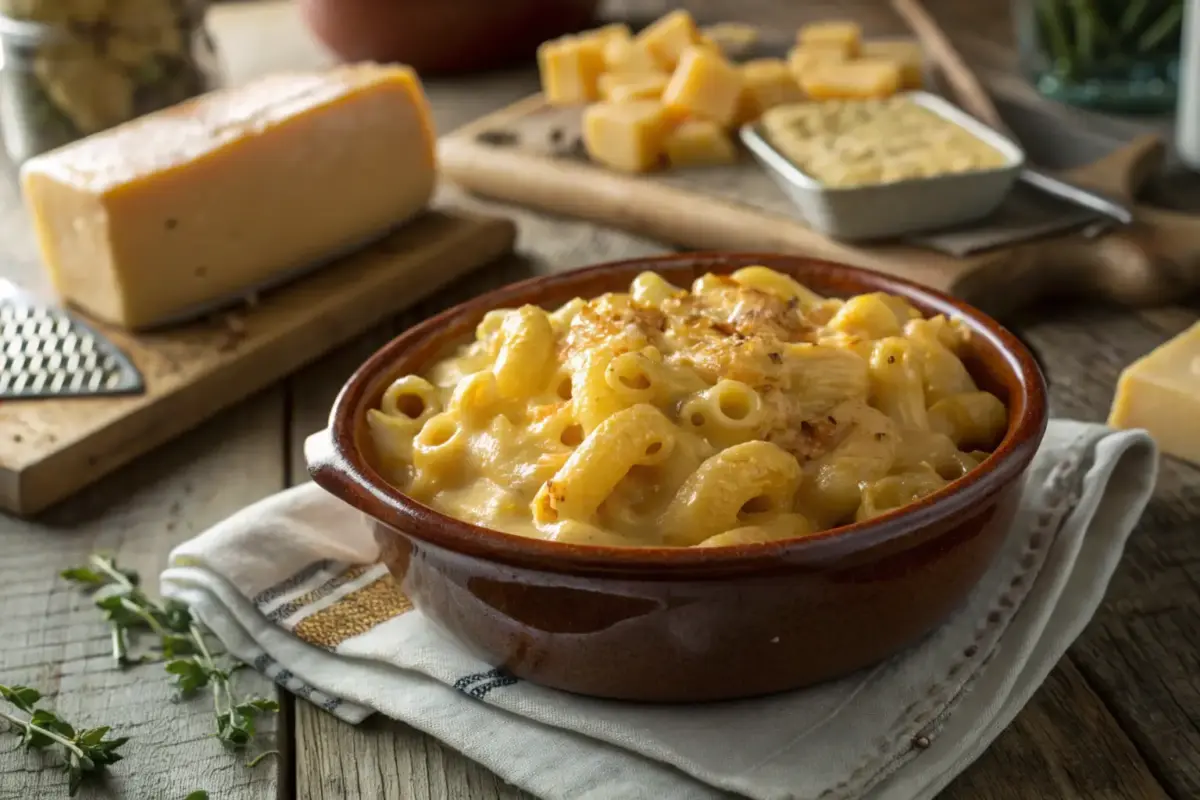Introduction
If you’re curious about what is in Gordon Ramsay mac and cheese, you’re not alone. This isn’t your average bowl of cheesy pasta. It’s a dish that combines the comfort we all crave with the sophistication you’d expect from a world-renowned chef. Whether you’re a lifelong mac and cheese fan or just dipping your toes into this beloved classic, Ramsay’s version promises to impress. Packed with rich flavors and gourmet touches, it’s a recipe that takes mac and cheese to a whole new level.
For a deeper dive into traditional techniques, explore our guide on Old-Fashioned Baked Macaroni and Cheese for a classic perspective.
Gordon Ramsay’s Approach to Classic Mac and Cheese
The Philosophy Behind the Recipe
At its heart, Gordon Ramsay’s mac and cheese is about balance. It honors the simplicity of the dish while adding layers of flavor that make it truly memorable. So, what is in Gordon Ramsay mac and cheese that makes it stand out? The answer lies in quality ingredients and careful preparation. Ramsay approaches this dish with the same dedication as any fine-dining recipe, proving that even comfort food deserves a little gourmet magic.
If you’re new to crafting mac and cheese, check out our tips on Avoiding Common Mac and Cheese Mistakes to ensure your dish turns out perfectly.
Elevating Comfort Food with Gourmet Techniques
One of the key reasons why Gordon Ramsay’s mac and cheese is so special is his attention to detail. Instead of relying on shortcuts, he takes the time to prepare a silky béchamel sauce and chooses a mix of cheeses that melt perfectly. This method ensures a dish that’s creamy, flavorful, and anything but ordinary. It’s no wonder people often ask, what is in Gordon Ramsay mac and cheese that makes it so irresistible? The secret lies in his commitment to elevating every element of the recipe.
The Main Ingredients in Gordon Ramsay’s Mac and Cheese
Types of Pasta Used and Why
When it comes to pasta, Gordon Ramsay doesn’t settle for the basics. Instead of traditional elbow macaroni, he often uses shapes like cavatappi or orecchiette. These pastas have ridges and curves that hold onto the sauce beautifully, ensuring every bite is packed with flavor. So if you’re wondering what is in Gordon Ramsay mac and cheese that sets it apart, the choice of pasta is a small but crucial detail.
The Cheese Selection: Flavor and Texture Combinations

Cheese is, of course, the star of the show in mac and cheese, and Gordon Ramsay doesn’t skimp here. His recipe typically features a blend of sharp cheddar, nutty Gruyère, and salty Parmesan. This combination creates a rich and complex flavor profile that’s hard to beat. Add a splash of cream to tie it all together, and you’ve got a sauce that’s perfectly smooth and indulgent. For an alternative approach, learn why some cooks prefer Evaporated Milk in Mac and Cheese for an ultra-creamy texture.
So, there you have it. From the choice of pasta to the cheese selection, every ingredient in Gordon Ramsay’s mac and cheese is carefully chosen to create a dish that’s both comforting and gourmet. And honestly, isn’t that what great food is all about?
Secret Ingredients That Make It Stand Out
Enhancing the Creaminess: Unexpected Additions
Here’s a little surprise for you—Gordon Ramsay doesn’t stick to just milk and cheese for his mac and cheese sauce. He adds a touch of crème fraîche or mascarpone to give the dish a creamy texture that feels luxurious without being heavy. This addition is what makes the sauce so velvety smooth. Another twist? A dash of Dijon mustard. It might sound unusual, but trust me, it adds a subtle tang that brings the flavors to life. It’s these little details that take his recipe from ordinary to extraordinary.
Spices and Seasonings for a Unique Flavor Profile
If you’ve ever wondered why Ramsay’s mac and cheese has such a depth of flavor, the answer lies in the spices. He doesn’t stop at salt and pepper. A pinch of paprika adds warmth and a smoky undertone, while a hint of nutmeg gives the sauce a subtle richness that pairs beautifully with the cheese. Oh, and let’s not forget the garlic—just enough to give the dish a savory kick without overpowering the other flavors. These seasonings may be simple, but when combined, they create a flavor profile that’s anything but basic.
Cooking Techniques for the Perfect Mac and Cheese
The Role of Sauce Preparation

The sauce is where the magic happens, and Ramsay doesn’t mess around. He starts with a classic roux—equal parts butter and flour whisked together until golden. This forms the base of the béchamel sauce, which is then enriched with milk, cream, and that dreamy mix of cheeses. The key here is patience. You’ve got to stir the sauce constantly and let the cheese melt slowly to avoid any clumps. The result? A smooth, silky sauce that clings perfectly to the pasta.
Ensuring Pasta Complements the Sauce
Let’s talk pasta for a second. Ramsay insists on cooking it al dente, which means it’s firm to the bite. Why? Because the pasta will continue to cook slightly when it’s mixed with the hot sauce, and you don’t want it turning mushy. He also recommends reserving a bit of the pasta water to thin out the sauce if needed. This starchy water helps the sauce stick to the pasta like a dream, creating a dish that’s perfectly cohesive and downright irresistible.
Variations of Gordon Ramsay’s Recipe
Vegan or Dairy-Free Adaptations
Good news for plant-based eaters—this recipe can be tweaked to suit a vegan or dairy-free diet. Swap out the traditional cheeses for a mix of plant-based cheese alternatives, and use coconut cream or almond milk in place of dairy. You can even make a roux with olive oil instead of butter. The key is finding vegan cheeses that melt well and offer bold flavors to replicate the richness of the original recipe.
Baked Version vs. Stovetop Preparation
If you’re wondering whether to bake your mac and cheese or serve it straight from the stovetop, Ramsay has a preference for both depending on the occasion. For a creamy, indulgent dish, the stovetop version is the way to go. But if you’re feeding a crowd or want a crispy topping, the baked version is hard to beat. Simply sprinkle some breadcrumbs mixed with Parmesan and a bit of melted butter over the top, then pop it in the oven until golden and bubbly. It’s a little extra work, but the crunch is totally worth it.
With these secrets and techniques in mind, you’re well on your way to mastering Gordon Ramsay’s mac and cheese. It’s not just about following the recipe—it’s about understanding the why behind each step. And trust me, once you’ve nailed it, you’ll never look at mac and cheese the same way again.
Pairing Ideas for What is in Gordon Ramsay Mac and Cheese
Perfect Side Dishes for Gordon Ramsay’s Mac and Cheese
Gordon Ramsay’s mac and cheese is rich and hearty on its own, but pairing it with the right side dishes can make the meal even better. A crisp green salad with a tangy vinaigrette is a classic choice—it cuts through the richness and adds a fresh element to the plate. For something heartier, roasted vegetables like Brussels sprouts or asparagus work beautifully. If you’re feeling indulgent, garlic bread or even fried chicken can take things to the next level. It’s all about balancing textures and flavors, so you’re not overwhelmed by too much creaminess in one meal.
Beverage Pairings for Gordon Ramsay’s Gourmet Mac and Cheese
What you drink with your mac and cheese can make or break the meal. For adults, a glass of dry white wine or a light beer pairs perfectly, cutting through the richness of the cheese sauce. If you’re keeping things family-friendly, a sparkling water with a twist of lemon or lime is a refreshing option. And for the kids? You can’t go wrong with a classic glass of milk—sometimes the simplest choices are the best.
Nutritional Insights into What is in Gordon Ramsay Mac and Cheese
Caloric Breakdown of Gordon Ramsay’s Mac and Cheese
Let’s talk numbers. Like most comfort foods, Gordon Ramsay’s mac and cheese isn’t exactly light on calories. A typical serving can range between 400 to 600 calories, depending on portion size and whether you’re going all-in with cream and butter. The cheese contributes most of the calories, along with the pasta and cream. While it’s not an everyday meal, it’s a treat worth savoring when you’re craving something indulgent.
Healthier Ingredient Substitutions in Gordon Ramsay’s Mac and Cheese
If you’re looking to lighten up the dish without sacrificing flavor, there are plenty of tweaks you can make. Swap out regular pasta for whole wheat or chickpea-based options to add fiber and protein. Use low-fat milk instead of cream, and consider reducing the amount of cheese by using a sharper variety—you’ll need less to get the same flavor impact. Adding vegetables like spinach or roasted cauliflower can also boost the nutritional profile while keeping the dish satisfying.
Common Mistakes to Avoid When Recreating What is in Gordon Ramsay Mac and Cheese
Overcooking the Pasta
One of the easiest mistakes to make is overcooking the pasta. Remember, pasta continues to cook a little after it’s drained, especially when it’s mixed with a hot sauce. If you let it go too long in the pot, you’ll end up with mushy noodles that won’t hold their shape. Stick to the recommended al dente cooking time, and taste-test as you go to be sure.
Balancing the Cheese-to-Sauce Ratio
Another common issue is getting the cheese-to-sauce ratio wrong. Too much cheese, and the dish can turn greasy. Too little, and it won’t have that rich, gooey texture you’re looking for. The key is to add the cheese gradually and taste as you go. If the sauce feels too thick, a splash of pasta water can help loosen it up without diluting the flavor.
FAQs
What are the ingredients in Gordon’s mac and cheese?
The main ingredients in Gordon Ramsay’s mac and cheese include pasta (typically cavatappi or another shape that holds sauce well), a mix of cheeses like cheddar, Gruyère, and Parmesan, milk or cream, butter, and a few surprising additions like Dijon mustard and nutmeg for extra flavor. Don’t forget the optional breadcrumbs for a crispy baked topping.
How does Gordon Ramsay make mac and cheese?
Gordon Ramsay starts with a roux made from butter and flour, which forms the base of a creamy béchamel sauce. He slowly adds milk and a blend of cheeses, stirring constantly to create a smooth sauce. The cooked pasta is mixed in, ensuring every piece is coated. If baking, he tops it with breadcrumbs and Parmesan before popping it in the oven until golden and bubbly.
Which celebrity makes the best mac and cheese?
While Gordon Ramsay’s mac and cheese is undoubtedly a standout, other celebrity chefs like Martha Stewart and Ina Garten also have their own iconic versions. Each brings something unique to the table, but Ramsay’s recipe is known for its balance of comfort and gourmet flair, making it a fan favorite.
What is the thickening agent in mac and cheese?
The thickening agent in mac and cheese is typically a roux, which is a mixture of butter and flour cooked together. This base helps thicken the béchamel sauce, allowing it to cling to the pasta and create that creamy, luscious texture we all love.
Conclusion
Gordon Ramsay’s mac and cheese is more than just a dish—it’s an experience. From the carefully chosen ingredients to the thoughtful techniques, every element is designed to create something truly special. Whether you stick to the classic recipe or experiment with your own twists, this is comfort food at its finest. So next time you’re craving something warm, cheesy, and downright delicious, why not give it a try? You might just find it becomes a staple in your kitchen.


1 thought on “What Is in Gordon Ramsay Mac and Cheese? Tips for Perfecting the Dish”